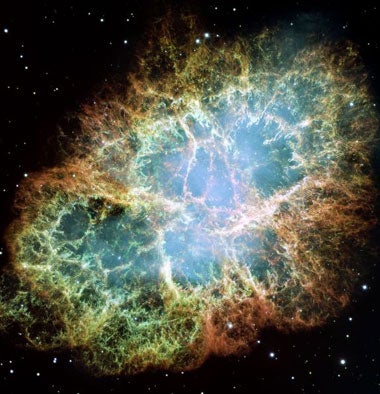Crab Nebula captured by Hubble

The remnants of a space explosion that occurred over 1,000 years ago have been captured by the Hubble Space Telescope.
The long-dead Crab Nebula in the Taurus constellation is the six-light-year-wide remains of a star's supernova explosion.
Japanese and Chinese astronomers recorded the event from Earth in 1054, when a star 6,500 light-years away from them exploded. (One light-year, 5.8 trillion miles, is the distance light travels in one year.)
The mosaic image, composed from pictures taken over three years, is one of the largest ever produced with the Earth-orbiting observatory and gives the clearest view of the supernova yet.
The Crab Nebula acquired its name after Irish astronomer Lord Rosse made a drawing of it in 1844, using a 36-inch telescope.
The orange filaments are the tattered remains of the star and consist mostly of hydrogen. At the centre of the Crab Nebula is the neutron star, spinning 30 times per second. The colours in the image show the elements that were expelled from the star during the explosion. The blue in the outer part represents neutral oxygen, and comes from electrons whirling almost at the speed of light. The green is singly-ionised sulfur, and red indicates doubly-ionised oxygen.
The newly composed image was assembled from 24 exposures taken in October 1999, January 2000 and December 2000. Astronomers used Hubble's Wide Field and Planetary Camera 2 to build the image.
Join our commenting forum
Join thought-provoking conversations, follow other Independent readers and see their replies
Comments